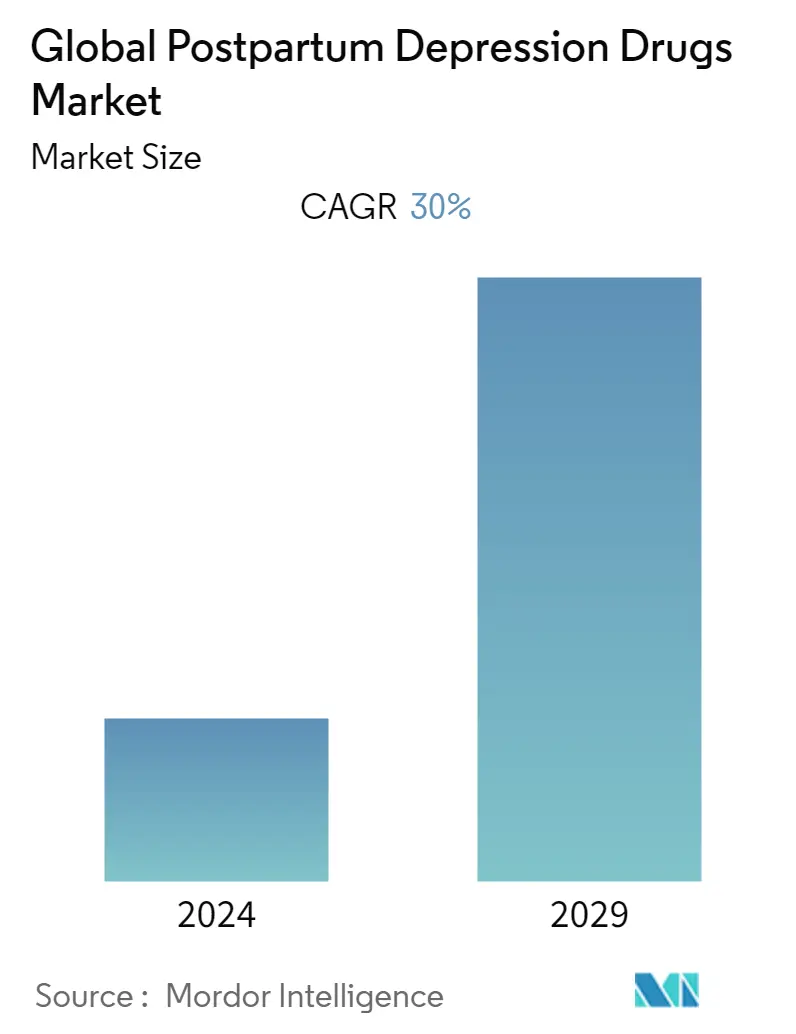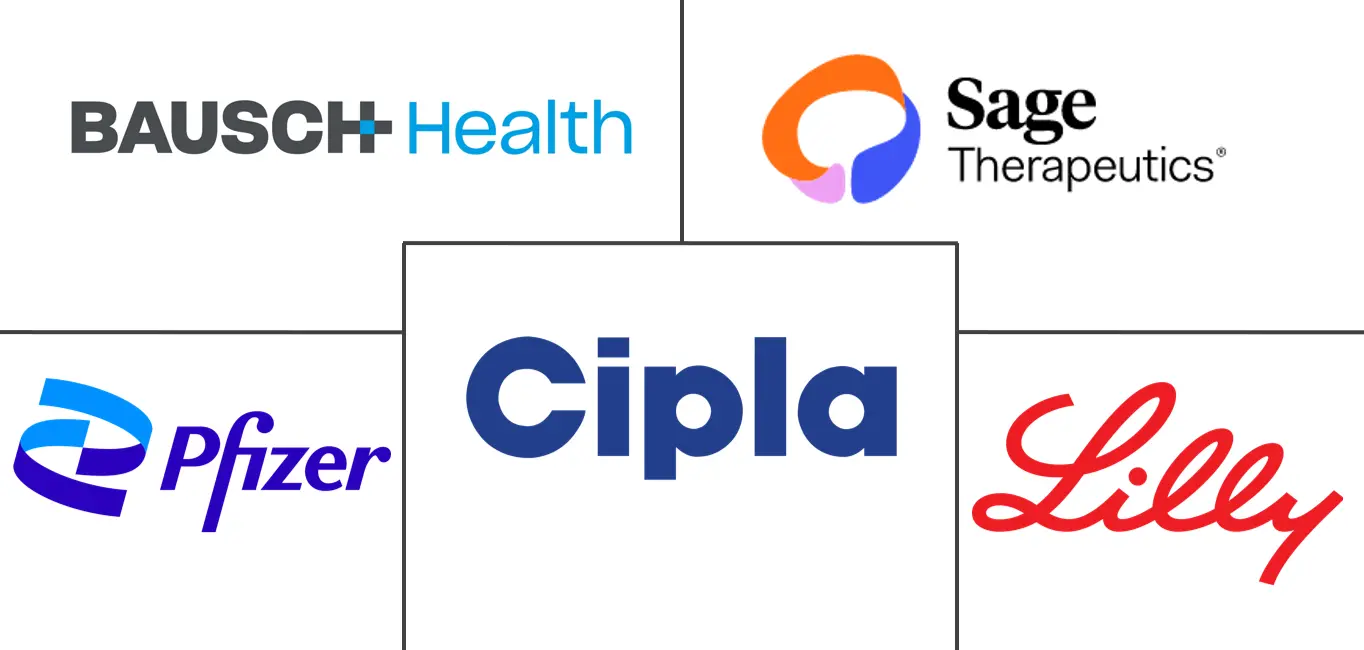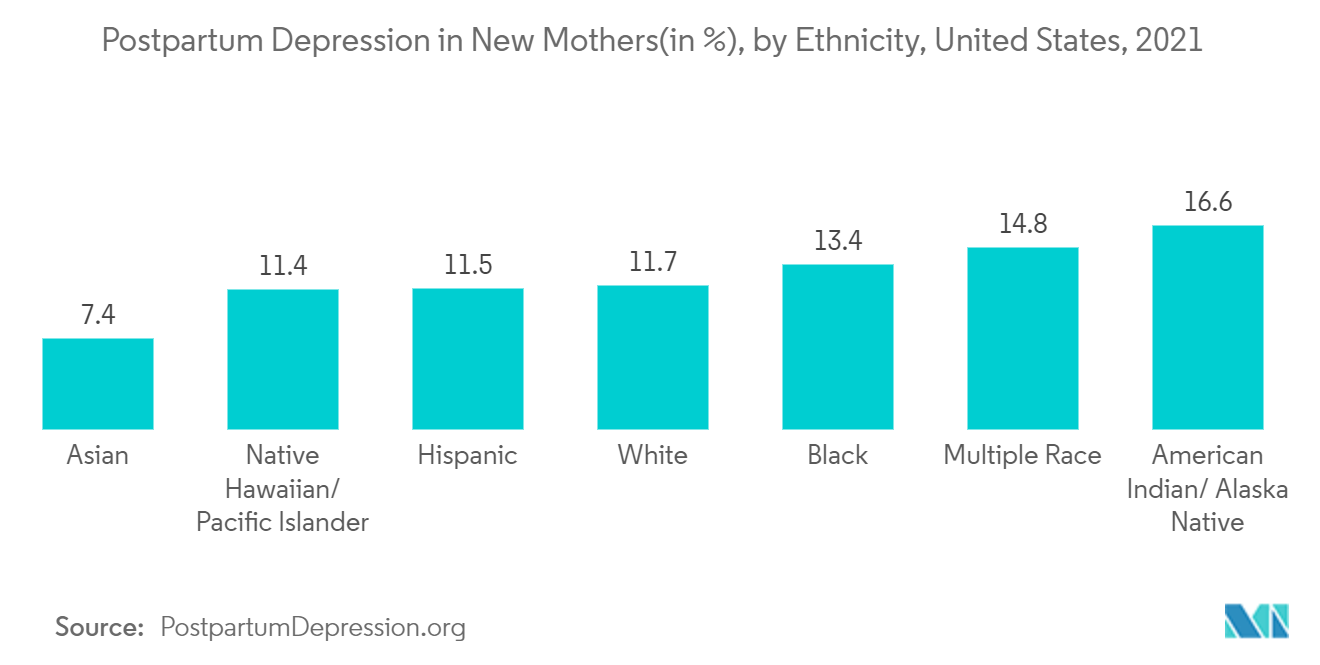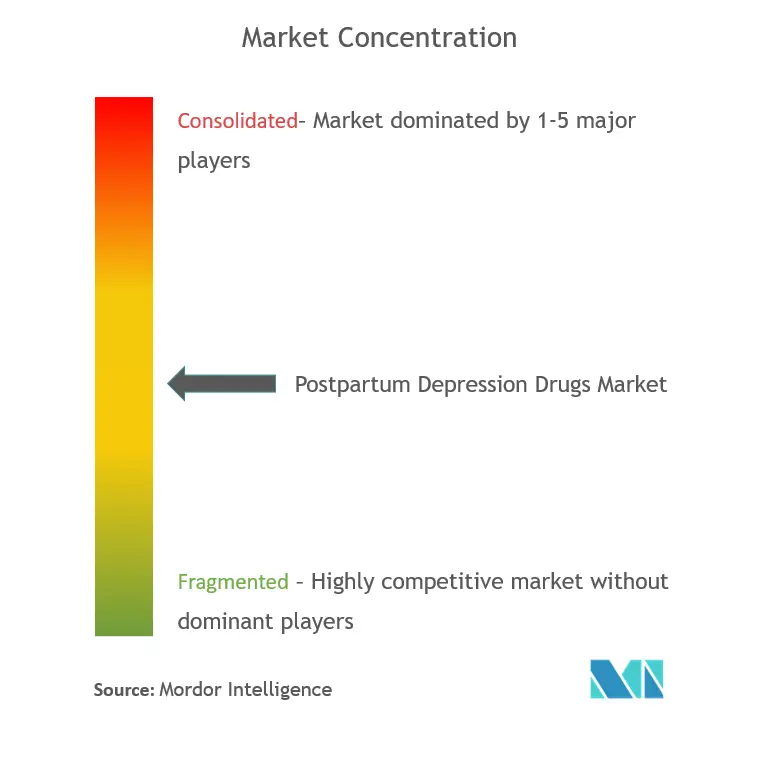Postpartum Depression Drugs Market Size

| Study Period | 2019 - 2029 |
| Base Year For Estimation | 2023 |
| Forecast Data Period | 2024 - 2029 |
| CAGR | 30.00 % |
| Fastest Growing Market | Asia-Pacific |
| Largest Market | North America |
Major Players
*Disclaimer: Major Players sorted in no particular order |
Need a report that reflects how COVID-19 has impacted this market and its growth?
Postpartum Depression Drugs Market Analysis
Postpartum depression drugs are expected to register a CAGR of 30% during the forecast period (2022-2027).
Covid-19 had a significant impact on the postpartum drug market. Since the beginning of 2020, the Covid-19 pandemic has changed the healthcare system as well as affected the lifestyle of the population worldwide. People were stuck indoors for months and suffered mental health problems increasingly. The increased mental health issues and disorders increased the demand for depression medicines. Also, research shows that childbearing mothers were drastically affected by the lockdowns and closures. This increased the chances of postpartum depression among pregnant women. Additionally, increasing research on the impact of Covid-19 on the mental health of childbearing mothers and the prevalence of PPD increased during the pandemic. For instance, an article was published in the International Journal of Environmental Research and Public Health in February 2022, which aimed to estimate the influence of the COVID-19 pandemic on the prevalence of postpartum depression (PPD) and to summarize risk factors for PPD during the COVID-19 pandemic. As per the study findings, the COVID-19 pandemic was anticipated to have detrimental effects on maternal mental wellbeing among women after childbirth. Also, the study highlighted that the prevalence of PPD in the survey was higher than the incidents ranging from 10% to 22% during the COVID-19 pandemic. Therefore, the Covid-19 pandemic is predicted to have a significant demand for PPD drugs, impacting the overall growth of the market studied.
Factors such as a surge in product launches coupled with frequent product approvals and an increase in research and development activities are bolstering the growth of the PPD drugs market. Additionally, an increase in awareness about postpartum depression (PPD) is creating opportunities for the overall market studied. Additionally, clinical trials are increasing for developing new drugs for postpartum depression. For instance, as of 26th May 2022, 350 clinical trials have been registered for postpartum depression in the clinicaltrial.gov registry, among which 16 clinical trials were registered in 2020 and 17 were registered in the year 2021. This increasing number of clinical trials for developing drugs for PPD is hence, creating demand for new drugs, bolstering the overall studied market.
The increasing prevalence of PPD globally is increasing the demand for PPD drugs. The insights on the PPD prevalence and incidence worldwide show that there is a consistent rise in postpartum depression among childbearing mothers. A study was conducted to assess the prevalence of PPD and factors associated with it among a sample of mothers from the Central Region of Eritrea. The study was conducted in a regional health facility. This study was published online in October 2020 in BMC Public Health. As per the study, it is estimated that 20 to 40% of women in low-income countries experience depression during pregnancy or the postpartum period. The prevalence of PPD shows a wide variation, affecting 8-50% of postnatal mothers across countries. Hence, the prevalence of PPD globally is demanding innovative therapeutics for the PPD, driving the studied market growth.
Additionally, the recent rising development in the market is anticipated to rise the demand for PPD drugs in the future. For instance, In May 2022, a new quality improvement (QI) study from Cedars-Sinai suggested that Nurse education is the key to successfully screening women for postpartum depression, which affects 15% of mothers and moms with postpartum depression benefit from improved screening. These developments are predicted to drive the studied market growth.
Therefore, the insights mentioned above are expected to propel the PPD drugs market growth globally in the future. However, the excessive cost of PPD drugs is predicted to hinder market growth in the future.
Postpartum Depression Drugs Market Trends
This section covers the major market trends shaping the Postpartum Depression Drugs Market according to our research experts:
Postpartum Anxiety by Type is Expected to Witness Growth Over the Forecast Period
Postpartum anxiety is when a person feels excessive anxiety during the postpartum period following childbirth. Sometimes the severity of the postpartum anxiety may interfere with a person's ability to function in everyday tasks. Hence, the burden of postpartum anxiety is anticipated to bolster the growth of the segment over the analysis period.
Postpartum depression sometimes carries generalized anxiety, which becomes severe over time, and it has become a serious mental health concern globally. The data published by PostpartumDepression.org updates from March 2022, Women with a history of depression, anxiety disorders, or serious mood disorders are 30% to 35% more likely to develop postpartum depression. Also, the data showed that younger mothers of age 25 and below were more likely to develop postpartum depression or anxiety and the prevalence for this group was 30% compared to 23% for other age groups. Thus, the prevalence and incidence of postpartum anxiety are predicted to witness segment growth over the future.
Furthermore, a study titled "Prevalence of Maternal Postnatal Anxiety and Its Association With Demographic and Socioeconomic Factors: A Multicenter Study in Italy" published in September 2021 showed that when 307 mothers aged 18 years or more with a biological baby of fewer than 52 weeks from seven Italian healthcare centers were evaluated overall prevalence of self-reported postnatal anxious symptoms of 34.2% were reported, while the prevalence was 34.5% at 1-24 weeks postpartum, and 30.8% at more than 24 weeks postpartum specifically. Hence, the increasing research to find out the prevalence of postpartum anxiety is increasing, driving the segment's growth.
Therefore, the postpartum anxiety segment is anticipated to grow over the forecast period, driving the demand for therapies and drugs for treatment, positively impacting the overall studied market.

North America is Expected to Dominate the Market Over the Forecast Period
Feelings of postpartum depression (PPD) are more intense and last longer than expected. Postpartum depression is a common public health concern in the North American region among women after childbirth. This region is anticipated to dominate the PPD drugs market owing to the rising prevalence of PPD across the countries in the region.
The Centers for Disease Control and Prevention (CDC) data updated in May 2022 shows that about 1 in 8 women with a recent live birth experience symptoms of postpartum depression in the United States, and the estimates of the number of women affected by postpartum depression differ by age, race/ethnicity, and state. In addition, a population-based, repeated cross-sectional study was conducted in Ontario, Canada, to analyze Postpartum mental illness during the COVID-19 pandemic. The results were published online in June 2021 in the Canadian Medical Association Journal (CMAJ). As per the study results over the first nine months of the COVID-19 pandemic, clinical visits for postpartum mental illness were significantly more frequent, and higher visit rates were seen in both primary and specialist care in the region. Hence, the prevalence of PPD and physician visits in the countries across North America is creating demand for PPD drugs which alternatively is expected to drive the studied market growth over the forecast period.
Furthermore, the initiatives taken by the government and private organizations are increasing awareness among the North American target population for the treatment of PPD, which is predicted to drive the studied market growth. For instance, in April 2022, American Psychiatric Association (APA) launched a new initiative, the Mental Health Needs Assessment in the Management of Perinatal Psychiatric Disorders which is supported by a grant from the Center for Disease Control and Prevention (CDC) to address gaps in the treatment of perinatal mental health problems. Following the launch at the same time, in May 2022, the Health Resources and Services Administration (HSRA) launched a toll-free hotline for expecting and new mothers experiencing mental health challenges, where trained counselors will provide brief interventions and referrals to community-based and telehealth providers as needed. Thus, the rise in initiatives is expected to create more opportunities for PPD drugs in the region, driving the overall market growth.
Moreover, the clinical trials are increasing the number of countries in the region developing advanced drugs for PPD. The data retrieved from the clinicaltrials.gov website shows that 193 clinical trials have been registered in the North America region as of May 26th, 2022, among which 153 clinical trials have been registered in the United States itself, followed by 41 in Canada and 2 in Mexico. The number of clinical trials for developing PPD drugs is predicted to drive the studied market growth over the analysis period.
Additionally, the approval of drugs is also propelling the growth of the market. For instance, in May 2021, Woebot Heath received United States Food and Drug Administration (FDA) Breakthrough Device Designation for the company's digital therapeutic for the treatment of postpartum depression (PPD). WB001 is an investigational digital therapeutic, delivered over eight weeks via a patient's smartphone, that combines cognitive behavioral therapy (CBT) and elements of interpersonal psychotherapy (IPT) with a deep understanding of the lived experience of PPD to reduce symptoms of postpartum depression.
Therefore, owing to the factors mentioned above, the PPD drugs market is anticipated to see growth over the forecast period in the North American region.

Postpartum Depression Drugs Industry Overview
In the current scenario, the number of product launches, collaborations, and other strategies by the market players is increasing, and it is fueling the global postpartum depression market. The market is competitive in local markets, and globally the market is fairly consolidated due to the lack of presence of major players in the global market. Pfizer Inc., Sage Therapeutics, Inc., Bausch Health Companies Inc., Cipla Inc., and Lilly are some of the major players, among others.
Postpartum Depression Drugs Market Leaders
-
Pfizer Inc.
-
Bausch Health Companies Inc.
-
Lilly
-
Sage Therapeutics, Inc.
-
Cipla Inc.
*Disclaimer: Major Players sorted in no particular order

Postpartum Depression Drugs Market News
- In May 2022, eIntegrity, a Health Education England program in partnership with the NHS and professionals, launched a new program for Perinatal Mental Health.
- In March 2022, Providence, a United States-based organization, launched a behavioral health program for new moms and their babies. The Perinatal RISE Program (P-RISE) is an intensive outpatient resource specifically for people who are pregnant or up to one year post-partum.
Postpartum Depression Drugs Market Report - Table of Contents
1. INTRODUCTION
- 1.1 Study Assumptions and Market Definition
- 1.2 Scope of the Study
2. RESEARCH METHODOLOGY
3. EXECUTIVE SUMMARY
4. MARKET DYNAMICS
- 4.1 Market Overview
-
4.2 Market Drivers
- 4.2.1 Surge in Product Launches Coupled with Frequent Product Approvals
- 4.2.2 Increase in Research and Development Activities
- 4.2.3 Increase in Awareness about Postpartum Depression (PPD)
-
4.3 Market Restraints
- 4.3.1 Excessive Cost of PPD Drugs
-
4.4 Porter's Five Forces Analysis
- 4.4.1 Threat of New Entrants
- 4.4.2 Bargaining Power of Buyers/Consumers
- 4.4.3 Bargaining Power of Suppliers
- 4.4.4 Threat of Substitute Products
- 4.4.5 Intensity of Competitive Rivalry
5. MARKET SEGMENTATION
-
5.1 By Type
- 5.1.1 Postpartum Anxiety
- 5.1.2 Postpartum Post-Traumatic Stress Disorder
- 5.1.3 Postpartum Panic Disorder
- 5.1.4 Postpartum Psychosis
- 5.1.5 Others
-
5.2 By Treatment
- 5.2.1 Psychotherapy
- 5.2.2 Supplements
- 5.2.3 Others
-
5.3 By Route of Administration
- 5.3.1 Oral
- 5.3.2 Others
-
5.4 By End Users
- 5.4.1 Hospitals and Clinics
- 5.4.2 Specialty Centers
- 5.4.3 Others
-
5.5 Geography
- 5.5.1 North America
- 5.5.1.1 United States
- 5.5.1.2 Canada
- 5.5.1.3 Mexico
- 5.5.2 Europe
- 5.5.2.1 United Kingdom
- 5.5.2.2 France
- 5.5.2.3 Germany
- 5.5.2.4 Italy
- 5.5.2.5 Spain
- 5.5.2.6 Rest of Europe
- 5.5.3 Asia-Pacific
- 5.5.3.1 India
- 5.5.3.2 China
- 5.5.3.3 Japan
- 5.5.3.4 Australia
- 5.5.3.5 South Korea
- 5.5.3.6 Rest of Asia-Pacific
- 5.5.4 Middle-East and Africa
- 5.5.4.1 GCC
- 5.5.4.2 South Africa
- 5.5.4.3 Rest of Middle-East and Africa
- 5.5.5 South America
- 5.5.5.1 Brazil
- 5.5.5.2 Argentina
- 5.5.5.3 Rest of South America
6. COMPANY PROFILES AND COMPETITIVE LANDSCAPE
-
6.1 Company Profiles
- 6.1.1 Pfizer Inc.
- 6.1.2 Sage Therapeutics, Inc.
- 6.1.3 Bausch Health Companies Inc.
- 6.1.4 Lilly
- 6.1.5 Aurobindo Pharma
- 6.1.6 Lupin
- 6.1.7 Sun Pharmaceutical Industries Ltd.
- 6.1.8 SHIONOGI & Co., Ltd.
- 6.1.9 Cipla Inc.
- 6.1.10 Teva Pharmaceutical Industries Ltd.
- *List Not Exhaustive
7. MARKET OPPORTUNITIES AND FUTURE TRENDS
** Subject To AvailablityPostpartum Depression Drugs Industry Segmentation
As per the scope of the report, postpartum depression, or PPD, is the depression associated with pregnancy or after childbirth. Several drugs are used for postpartum depression, and antidepressants are prescribed. The postpartum depression drugs market is segmented by Type (Postpartum Anxiety, Postpartum Post-Traumatic Stress Disorder, Postpartum Panic Disorder, Postpartum Psychosis, and Others), Treatment (Psychotherapy, Supplements, and Others), Route of Administration (Oral and Others), End Users (Hospitals and Clinics, Specialty Centers, and Others), and Geography (North America, Europe, Asia-Pacific, Middle East & Africa, and South America). The market report also covers the estimated market sizes and trends for 17 different countries across major regions, globally. The report offers the value (in USD million) for the above segments.
| By Type | Postpartum Anxiety | |
| Postpartum Post-Traumatic Stress Disorder | ||
| Postpartum Panic Disorder | ||
| Postpartum Psychosis | ||
| Others | ||
| By Treatment | Psychotherapy | |
| Supplements | ||
| Others | ||
| By Route of Administration | Oral | |
| Others | ||
| By End Users | Hospitals and Clinics | |
| Specialty Centers | ||
| Others | ||
| Geography | North America | United States |
| Canada | ||
| Mexico | ||
| Geography | Europe | United Kingdom |
| France | ||
| Germany | ||
| Italy | ||
| Spain | ||
| Rest of Europe | ||
| Geography | Asia-Pacific | India |
| China | ||
| Japan | ||
| Australia | ||
| South Korea | ||
| Rest of Asia-Pacific | ||
| Geography | Middle-East and Africa | GCC |
| South Africa | ||
| Rest of Middle-East and Africa | ||
| Geography | South America | Brazil |
| Argentina | ||
| Rest of South America |
Postpartum Depression Drugs Market Research FAQs
What is the current Global Postpartum Depression Drugs Market size?
The Global Postpartum Depression Drugs Market is projected to register a CAGR of 30% during the forecast period (2024-2029)
Who are the key players in Global Postpartum Depression Drugs Market?
Pfizer Inc., Bausch Health Companies Inc., Lilly, Sage Therapeutics, Inc. and Cipla Inc. are the major companies operating in the Global Postpartum Depression Drugs Market.
Which is the fastest growing region in Global Postpartum Depression Drugs Market?
Asia-Pacific is estimated to grow at the highest CAGR over the forecast period (2024-2029).
Which region has the biggest share in Global Postpartum Depression Drugs Market?
In 2024, the North America accounts for the largest market share in Global Postpartum Depression Drugs Market.
What years does this Global Postpartum Depression Drugs Market cover?
The report covers the Global Postpartum Depression Drugs Market historical market size for years: 2019, 2020, 2021, 2022 and 2023. The report also forecasts the Global Postpartum Depression Drugs Market size for years: 2024, 2025, 2026, 2027, 2028 and 2029.
Global Postpartum Depression Drugs Industry Report
Statistics for the 2024 Global Postpartum Depression Drugs market share, size and revenue growth rate, created by Mordor Intelligence™ Industry Reports. Global Postpartum Depression Drugs analysis includes a market forecast outlook to 2029 and historical overview. Get a sample of this industry analysis as a free report PDF download.

